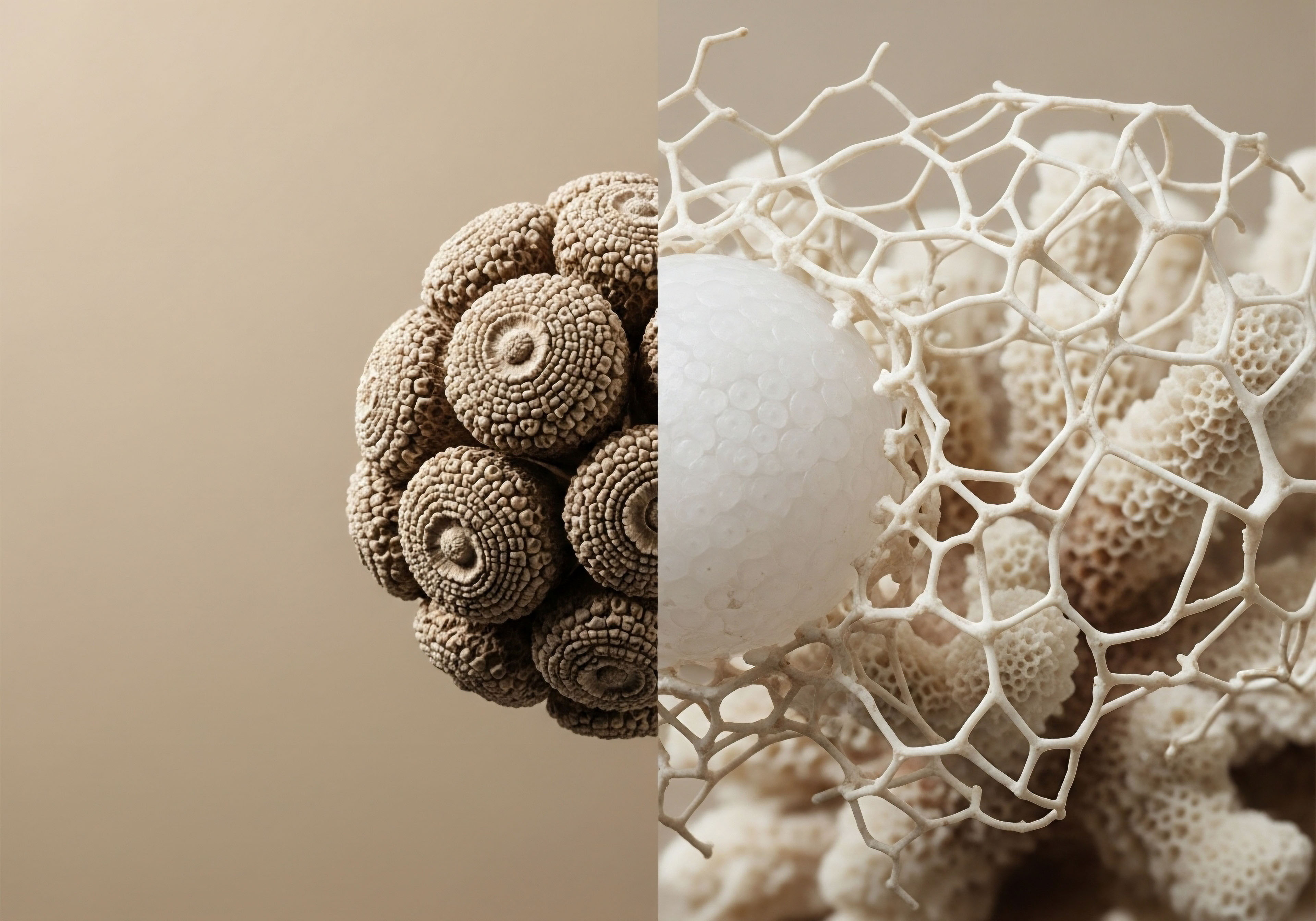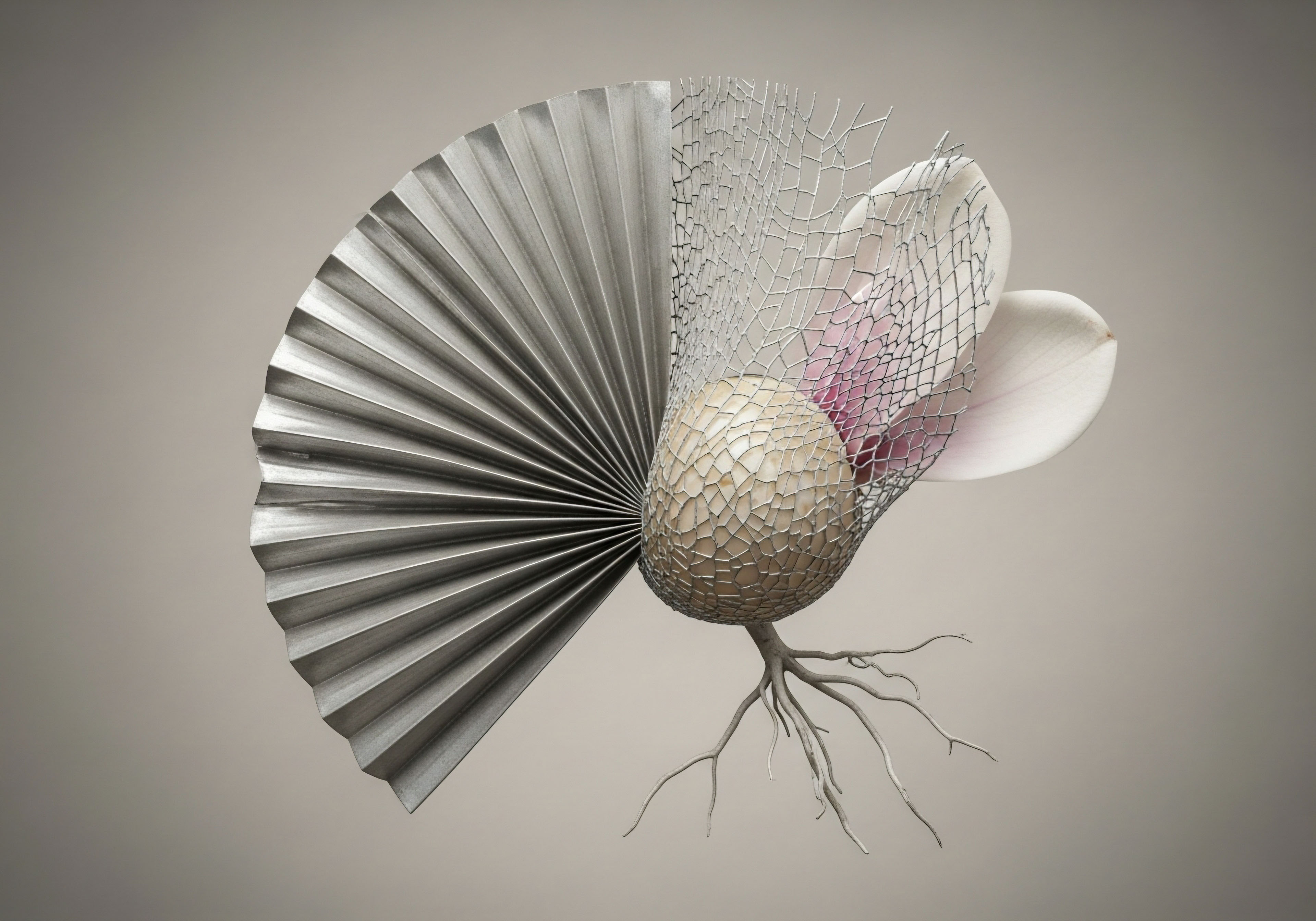

Fundamentals
You may be starting this journey because something feels misaligned. Perhaps it’s a subtle but persistent fatigue, a decline in physical performance, or a mental fog that clouds your focus. These are tangible experiences, and they are valid. Your body is a complex, interconnected system of communication networks.
When you feel that something is off, it is often a sign that a critical communication line has been disrupted. We can begin to understand this by looking at the profound relationship between your digestive system and your endocrine, or hormonal, system. This connection is one of the most foundational relationships in your entire physiology, and it holds a key to understanding why you feel the way you do.
Your hormonal health is governed by a precise chain of command known as the Hypothalamic-Pituitary-Gonadal (HPG) axis. Think of it as a finely tuned internal thermostat. The hypothalamus in your brain sends a signal to the pituitary gland, which in turn releases hormones that instruct the testes to produce testosterone.
This is a delicate feedback loop, where the body constantly monitors and adjusts output to maintain equilibrium. For decades, the approach to male hormonal health centered almost exclusively on this axis. Today, we recognize that a powerful, external force is constantly influencing this finely calibrated system ∞ the trillions of microorganisms residing in your gut.
This internal ecosystem, the gut microbiome, functions as a sophisticated chemical processing plant. It digests food, synthesizes vitamins, and, most importantly, regulates a significant portion of your body’s inflammation. When this microbial community is out of balance ∞ a state called dysbiosis ∞ it can lead to a low-grade, systemic inflammation that spreads throughout your body.
This inflammatory state is a major disruptor of the HPG axis. It sends a constant “danger” signal to your control centers, effectively telling the hypothalamus and pituitary to down-regulate non-essential functions, including the costly process of robust testosterone production. The fatigue and diminished vitality you experience are direct physiological consequences of this internal state of emergency.
The community of microbes within the gut acts as a central command center that directly influences the body’s hormonal signaling pathways.

The Gut as a Hormonal Regulator
The influence of your gut microbiome extends beyond simply creating inflammation. The bacteria themselves are active participants in hormonal metabolism. They produce enzymes and metabolic byproducts that can directly interact with and modify hormones circulating in your bloodstream.
For instance, the composition of your gut microbiota can affect the levels of Sex Hormone-Binding Globulin (SHBG), a protein that binds to testosterone and controls how much of it is available for your tissues to use. A healthy gut environment supports the proper balance, ensuring that testosterone is active and bioavailable.
Furthermore, certain families of gut bacteria are involved in the metabolism of other hormones, like estrogens. This bacterial population, sometimes called the “estrobolome,” helps regulate estrogen levels. In male physiology, managing the conversion of testosterone to estrogen is a key component of any successful optimization protocol.
An imbalanced microbiome can interfere with this process, contributing to the very side effects that hormonal therapies seek to avoid. This is why simply adding testosterone to the system without addressing the health of the gut is an incomplete strategy. It is akin to broadcasting a clear radio signal into an area filled with static interference; the message struggles to get through.

Probiotics as System Calibrators
This is where probiotics enter the conversation. Probiotics are specific strains of beneficial bacteria that, when introduced into the gut, can help restore balance to the microbial community. They work by competing with harmful bacteria for resources, strengthening the intestinal barrier to reduce systemic inflammation, and producing beneficial compounds like short-chain fatty acids (SCFAs).
These SCFAs are a primary fuel source for the cells lining your colon and play a direct role in calming the inflammatory signals that suppress testosterone production. Introducing targeted probiotics can be seen as a strategic intervention.
You are sending in reinforcements to help quell the internal static, allowing the body’s natural hormonal signals, and any therapeutic ones, to be transmitted and received with clarity. Understanding this connection is the first step in moving from simply treating a symptom to recalibrating the entire system for optimal function.


Intermediate
Understanding that the gut influences hormonal health is a foundational concept. The next step is to examine the precise mechanisms through which this influence is exerted and how we can strategically use this knowledge to enhance male hormone optimization protocols. The connection is biological and mechanical.
Probiotics are not a replacement for therapies like Testosterone Replacement Therapy (TRT); they are a synergistic component designed to prepare the body to receive and utilize these therapies with maximum efficacy and minimal disruption. A well-formulated hormonal protocol considers the entire biological terrain, and the gut is the ground upon which everything else is built.
The effectiveness of any hormonal therapy, whether it’s weekly injections of Testosterone Cypionate or the use of peptides to stimulate natural production, depends on the body’s inflammatory status. Chronic, low-grade inflammation, often originating from gut dysbiosis, directly impairs the function of the Leydig cells in the testes.
These are the specialized cells responsible for synthesizing testosterone in response to signals from the pituitary gland. When inflammatory molecules called cytokines are elevated, Leydig cell function is suppressed. This means that even with adequate signaling from the brain, the testes may struggle to produce testosterone efficiently. Probiotics can directly intervene in this process by helping to seal a permeable or “leaky” gut, preventing inflammatory molecules like lipopolysaccharides (LPS) from entering the bloodstream and triggering this suppressive inflammatory cascade.
Specific probiotic strains can modulate the immune system, directly reducing the inflammatory burden that suppresses testicular function.

Mechanisms of Probiotic Action on Male Hormones
The influence of probiotics on the male endocrine system can be understood through several distinct, yet overlapping, pathways. Each pathway represents a point of intervention where restoring microbial balance can lead to improved hormonal function and better outcomes from optimization therapies.
- Reduction of Systemic Inflammation ∞ Probiotic strains such as Lactobacillus and Bifidobacterium have been shown to strengthen the gut barrier. This prevents LPS, a component of certain bacterial cell walls, from leaking into circulation. LPS is a potent inflammatory trigger that directly inhibits testosterone production by the Leydig cells. By reducing this endotoxemia, probiotics lower the systemic inflammatory tone, creating a more favorable environment for hormone synthesis.
- Production of Short-Chain Fatty Acids (SCFAs) ∞ Beneficial bacteria ferment dietary fiber to produce SCFAs, including butyrate, propionate, and acetate. Butyrate is particularly important. It serves as the primary energy source for the cells lining the colon, enhances gut barrier integrity, and has systemic anti-inflammatory effects. These effects help protect the HPG axis from inflammatory disruption.
- Modulation of the Gut-Brain Axis ∞ The gut and brain are in constant communication. The microbiome produces a vast number of neurotransmitters, including approximately 90% of the body’s serotonin. An imbalanced microbiome can contribute to elevated levels of the stress hormone cortisol. Chronically high cortisol is catabolic and directly antagonistic to testosterone; it signals the body to break down tissue and suppress anabolic processes, including testosterone production. A healthier gut environment can support a more balanced stress response, protecting testosterone levels.
- Influence on Hormone Metabolism ∞ The gut microbiome directly participates in the life cycle of hormones. It can influence the activity of the enzyme beta-glucuronidase, which can reactivate metabolized estrogens in the gut, allowing them to be reabsorbed. For a man on TRT who is also using an aromatase inhibitor like Anastrozole to control estrogen, a dysbiotic gut could potentially interfere with this process, making estrogen management more challenging. A balanced microbiome supports more predictable hormone metabolism.

How Can Probiotics Augment a TRT Protocol?
A standard male hormone optimization protocol often involves Testosterone Cypionate, Gonadorelin to maintain testicular function, and Anastrozole to manage estrogen. The introduction of a targeted probiotic regimen can be viewed as foundational support for this structure. It addresses the underlying biological environment to ensure the protocol can function as intended. Let’s consider how this synergy works in practice.
| Protocol Component | Standard Goal | Potential Probiotic Synergy |
|---|---|---|
| Testosterone Cypionate | Restore serum testosterone to optimal levels, improving energy, libido, and muscle mass. | Reduces systemic inflammation, allowing for better cellular response to testosterone. May improve SHBG balance, increasing free testosterone availability. |
| Anastrozole | Block the aromatase enzyme to prevent the conversion of testosterone to estradiol, managing side effects. | Supports a healthy “estrobolome,” aiding in the proper excretion of metabolized estrogens and reducing the burden on the aromatase inhibitor. |
| Gonadorelin | Stimulates the pituitary to release LH and FSH, maintaining testicular size and endogenous hormone production pathways. | By lowering inflammation at the testicular level, probiotics create a more receptive environment for the signaling effects of LH, supporting Leydig cell health. |
| Overall Well-being | Alleviate symptoms of low testosterone such as fatigue, mood changes, and cognitive fog. | Improves gut-brain axis communication, potentially enhancing mood and cognitive function independently of, yet synergistically with, testosterone. |
While human studies are still emerging, the mechanistic evidence is compelling. Animal studies have provided intriguing results. For instance, research in mice showed that supplementation with Lactobacillus reuteri not only increased serum testosterone levels but also counteracted age-related testicular atrophy, preserving the size and function of the testes.
This suggests a direct, pro-vitality effect on the primary site of testosterone production. While we must be cautious in directly translating these findings to humans, they illuminate a powerful biological pathway that warrants clinical consideration. The goal is to create a system that is not just supplemented, but truly optimized from the ground up.


Academic
A systems-biology perspective on male endocrinology necessitates an appreciation of the gut microbiome as an integral endocrine organ. Its metabolic activity and communication with the host immune system position it as a critical modulator of the Hypothalamic-Pituitary-Gonadal (HPG) axis.
The influence is not peripheral; it is a direct, biochemical dialogue that can dictate the efficacy of endogenous production and exogenous hormone therapies. Examining the evidence from animal models and the few available human trials reveals specific mechanisms through which probiotics may influence male hormonal health, primarily by mitigating the inflammatory pressures that lead to testicular senescence and HPG axis suppression.
The central mechanism appears to be the amelioration of chronic, low-grade inflammation driven by intestinal dysbiosis and increased gut permeability. Lipopolysaccharide (LPS), an endotoxin from the outer membrane of Gram-negative bacteria, is a key antagonist of testicular steroidogenesis.
When gut barrier function is compromised, LPS translocates into systemic circulation, where it binds to Toll-like receptor 4 (TLR4) on immune cells and Leydig cells. This binding event initiates a signaling cascade that upregulates the production of pro-inflammatory cytokines such as Interleukin-6 (IL-6), Interleukin-1β (IL-1β), and Tumor Necrosis Factor-alpha (TNF-α).
These cytokines directly inhibit the expression of steroidogenic enzymes in Leydig cells, including Cholesterol Side-Chain Cleavage enzyme (P450scc) and 3β-hydroxysteroid dehydrogenase (3β-HSD), which are essential for the conversion of cholesterol to testosterone. Probiotic interventions, particularly with strains known to enhance gut barrier integrity like Lactobacillus rhamnosus and Bifidobacterium longum, are hypothesized to reduce this LPS translocation, thereby decreasing the inflammatory tone and protecting steroidogenic function.

What Is the Evidence for Specific Probiotic Strains?
The most compelling evidence for a direct effect of probiotics on male hormones comes from murine models. A landmark study by Poutahidis et al. (2014) demonstrated that supplementing the drinking water of aging male mice with Lactobacillus reuteri ATCC PTA 6475 resulted in significantly higher serum testosterone levels, increased testicular weight, and elevated Leydig cell numbers compared to controls.
The probiotic-fed mice exhibited what the researchers termed “lactic-acid-bacteria-induced testicular rejuvenation,” effectively reversing the age-associated testicular atrophy observed in the control group. The proposed mechanism was an IL-10-dependent suppression of systemic inflammation, as IL-10 is a potent anti-inflammatory cytokine. This suggests L. reuteri may promote a systemic anti-inflammatory phenotype that is conducive to robust testicular function.
However, translating these findings to human clinical practice has proven complex. A 2024 double-blind, placebo-controlled randomized clinical trial involving healthy men aged 55-65 investigated the effect of a multi-strain probiotic supplement on testosterone levels over 12 weeks. The study found no significant effect on total testosterone or other related hormones (like LH or SHBG) compared to placebo. This discrepancy between animal and human studies highlights several critical variables:
- Strain Specificity ∞ The positive effects in mice were seen with a specific strain, L. reuteri ATCC PTA 6475. The human trial used a different combination of strains. The endocrine effects of probiotics are likely highly strain-specific, and the optimal strains for male hormonal support are yet to be definitively identified.
- Host-Microbiome Interaction ∞ The baseline microbiome of an individual plays a significant role in how they respond to a probiotic. The homogenous, controlled environment of lab mice is vastly different from the diverse genetic and lifestyle backgrounds of a human population.
- Dosage and Duration ∞ The optimal dosage and duration of probiotic supplementation required to elicit a significant endocrine response in humans are unknown. The 12-week duration of the human trial may have been insufficient to induce measurable changes in the HPG axis.
The translation of promising results from murine models to human clinical trials remains a significant challenge in probiotic research for hormonal health.

Advanced Mechanistic Considerations
Beyond general inflammation, the microbiome’s role in hormone regulation is biochemically intricate. A deeper analysis points to several other areas where probiotic interventions could theoretically support male hormonal optimization protocols.
| Mechanism | Biochemical Pathway | Relevance to Hormone Optimization |
|---|---|---|
| SHBG Modulation | The liver produces Sex Hormone-Binding Globulin (SHBG). Gut dysbiosis and associated hepatic inflammation can alter SHBG production. Some studies suggest a correlation between microbiome composition and circulating SHBG levels. | Lowering elevated SHBG is a key goal for increasing bioavailable free testosterone. A healthier gut-liver axis, supported by probiotics, may contribute to optimizing SHBG levels. |
| Tryptophan Metabolism | Gut microbes metabolize the amino acid tryptophan down either the kynurenine pathway (pro-inflammatory) or the serotonin pathway (neurotransmitter synthesis). Dysbiosis favors the kynurenine pathway. | Increased kynurenine is associated with inflammation and depression, both of which are linked to lower testosterone. Shifting metabolism towards serotonin production via probiotics could improve mood and reduce inflammatory pressure on the HPG axis. |
| Micronutrient Bioavailability | A healthy microbiome is essential for the synthesis of B vitamins and Vitamin K, and the absorption of key minerals like zinc and magnesium from the diet. | Zinc and magnesium are critical co-factors for the enzymatic production of testosterone. Improved gut health ensures the building blocks for hormone synthesis are available. |

Could Probiotics Affect TRT Pharmacokinetics?
An underexplored area is the potential for the gut microbiome to influence the pharmacokinetics of orally administered medications used in hormonal protocols, such as Anastrozole or Clomiphene. The vast enzymatic capacity of the microbiome can metabolize drugs, potentially altering their absorption, efficacy, and side-effect profile.
While research in this specific area is nascent, it represents a significant frontier in personalized medicine. A patient’s microbiome composition could one day become a diagnostic tool to predict their response to certain therapeutic agents, allowing for the co-prescription of specific probiotics to optimize drug metabolism. This systems-based approach, which views the microbiome as an active participant in therapy, is the future of truly personalized hormone optimization.

References
- He, Mindy, and Y. T. Wang. “The impact of gut microbiota on serum testosterone and sex hormones.” Frontiers in Microbiology 14 (2023) ∞ 1184203.
- Poutahidis, Theofilos, et al. “Probiotic microbes sustain youthful serum testosterone levels and testicular size in aging mice.” PLoS One 9.1 (2014) ∞ e84877.
- LeBlanc, Jean Guy, et al. “Beneficial effects on host energy metabolism of short-chain fatty acids and vitamins produced by commensal and probiotic bacteria.” Microbial cell factories 16.1 (2017) ∞ 1-10.
- Andersson, M. et al. “Effects of probiotic supplementation on testosterone levels in healthy ageing men ∞ A 12-week double-blind, placebo-controlled randomized clinical trial.” Scandinavian Journal of Urology 58.3 (2024) ∞ 159-165.
- Maretti, C. and C. Cavallini. “The gut-testis axis ∞ the role of gut microbiota on male reproduction.” Journal of Clinical Medicine 11.13 (2022) ∞ 3634.

Reflection

Your Internal Ecosystem and Your Personal Path
The information presented here offers a new dimension to the understanding of your own body. It shifts the focus from a purely mechanical view of hormonal balance to a more ecological one. Your body is an environment, a complex system where different biological communities interact.
The health of your hormonal system is deeply connected to the health of the microbial community you host within you. This knowledge is empowering because it gives you a new area of influence, a new set of tools to work with on your path to reclaiming vitality.
Consider the signals your body has been sending you. The fatigue, the mental fog, the changes in physical capacity. These are not isolated events. They are data points, messages from a system that is seeking balance. By learning to support your internal ecosystem through conscious choices, you are not just addressing a symptom; you are nurturing the very foundation of your physiological function.
This journey of hormonal optimization is profoundly personal. The science provides the map, but you are the one navigating the terrain. The next step is to ask how this new understanding of your internal world can inform the choices you make for your health, creating a personalized protocol that is not just effective, but truly holistic and sustainable.



